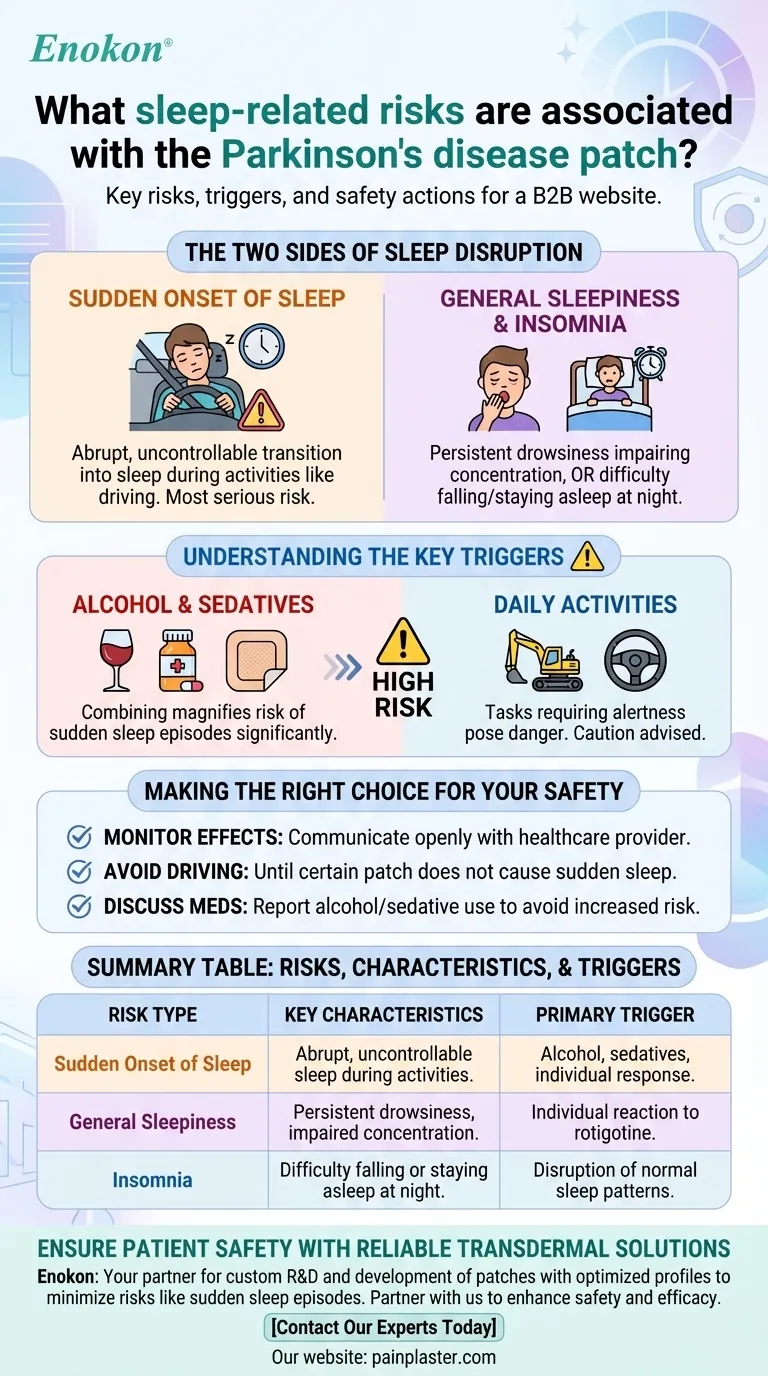The primary sleep-related risks of the Parkinson's disease patch are sudden, unpredictable sleep episodes during the day and a general feeling of intense sleepiness. Paradoxically, the patch can also cause insomnia in some individuals, making it difficult to sleep at night. These risks, particularly sudden sleep onset, are significantly increased when combined with alcohol or other sedating medications.
The most critical risk is not just feeling tired, but the potential to fall asleep suddenly and without warning during normal activities like driving. Understanding this specific danger and avoiding known triggers is essential for ensuring your safety.

The Two Sides of Sleep Disruption
The Parkinson's patch, which contains the active ingredient rotigotine, can affect sleep in two distinct and seemingly contradictory ways. It's crucial to understand the difference between them.
Sudden Onset of Sleep
This is the most serious sleep-related risk. It is not a gradual feeling of tiredness but an abrupt and uncontrollable transition into sleep.
These episodes can occur while you are engaged in normal daily activities, including eating, talking, or most critically, driving a vehicle.
General Sleepiness (Somnolence)
Separate from sudden sleep episodes, the patch can cause a more persistent state of drowsiness or sleepiness.
This can impair your ability to concentrate and function throughout the day, even if you do not fall asleep unexpectedly.
The Paradox of Insomnia
While the patch is more commonly associated with causing sleepiness, it can also disrupt normal sleep patterns and lead to insomnia.
This means some individuals may find it difficult to fall asleep or stay asleep at night, despite feeling drowsy during the day.
Understanding the Key Triggers
Certain factors can dramatically increase the likelihood and severity of these sleep-related side effects. Being aware of these triggers is a critical part of managing your treatment safely.
The Impact of Alcohol and Sedatives
Combining the patch with alcohol or other medications that cause sedation significantly magnifies the risk of sudden sleep episodes.
This includes prescription pain relievers, sleep aids, some antidepressants, and certain allergy medications. Always inform your doctor of all medications you are taking.
The Risk During Daily Activities
Because of the potential for sudden sleep onset, activities that require constant alertness pose a significant risk until you know how the medication affects you.
The warning against driving is paramount, as falling asleep at the wheel can have catastrophic consequences. Caution should also be applied to operating heavy machinery or any task where a lapse in attention could be dangerous.
Making the Right Choice for Your Safety
Your response to the patch is individual. The key is to monitor its effects closely and communicate openly with your healthcare provider to manage the risks effectively.
- If your primary focus is safety while driving: Do not drive or operate dangerous machinery until you and your doctor are certain the patch does not cause you to fall asleep suddenly.
- If you consume alcohol or take other sedatives: You must discuss this with your doctor, as the combination dramatically increases your risk of sudden sleep onset.
- If you are experiencing either daytime sleepiness or nighttime insomnia: Report this side effect to your provider, as it may require an adjustment to your treatment plan.
Proactively discussing these potential effects with your healthcare provider is the most effective way to ensure your treatment is both safe and beneficial.
Summary Table:
| Risk Type | Key Characteristics | Primary Trigger |
|---|---|---|
| Sudden Onset of Sleep | Abrupt, uncontrollable sleep during activities like driving. | Combination with alcohol or other sedatives. |
| General Sleepiness (Somnolence) | Persistent drowsiness impairing daily concentration. | Individual reaction to the medication (rotigotine). |
| Insomnia | Difficulty falling or staying asleep at night. | Disruption of normal sleep patterns by the patch. |
Ensure Patient Safety with Reliable Transdermal Solutions
Navigating the side effects of Parkinson's treatments requires a trusted manufacturing partner. Enokon is a bulk manufacturer of reliable transdermal patches and pain plasters for healthcare distributors and pharmaceutical brands.
We understand the critical balance between effective drug delivery and patient safety. Our technical expertise supports custom R&D and development, helping you create patches with optimized profiles to minimize risks like sudden sleep episodes.
Partner with us to enhance your product's safety and efficacy.
Contact our experts today to discuss your custom transdermal patch needs.
Visual Guide

Related Products
- Natural Herbal Wormwood Patch Pain Plaster
- Far Infrared Heat Pain Relief Patches Transdermal Patches
- Capsaicin Chili Medicated Pain Relief Patches
- Icy Hot Menthol Medicine Pain Relief Patch
- Medical Cooling Gel Patches for Fever Cooling Patches
People Also Ask
- What precautions should be taken when using pain relief patches? Essential Safety Guide
- What are pain relief patches? Discover Targeted, Drug-Free Pain Management Solutions
- Who should consult a healthcare professional before using pain relief patches? Ensure Your Safety with Medical Advice
- How do pain relief patches work? A Guide to Targeted, Long-Lasting Pain Relief
- Are pain relief patches safe for sensitive skin? Your Guide to Safe Use & Skin Testing














